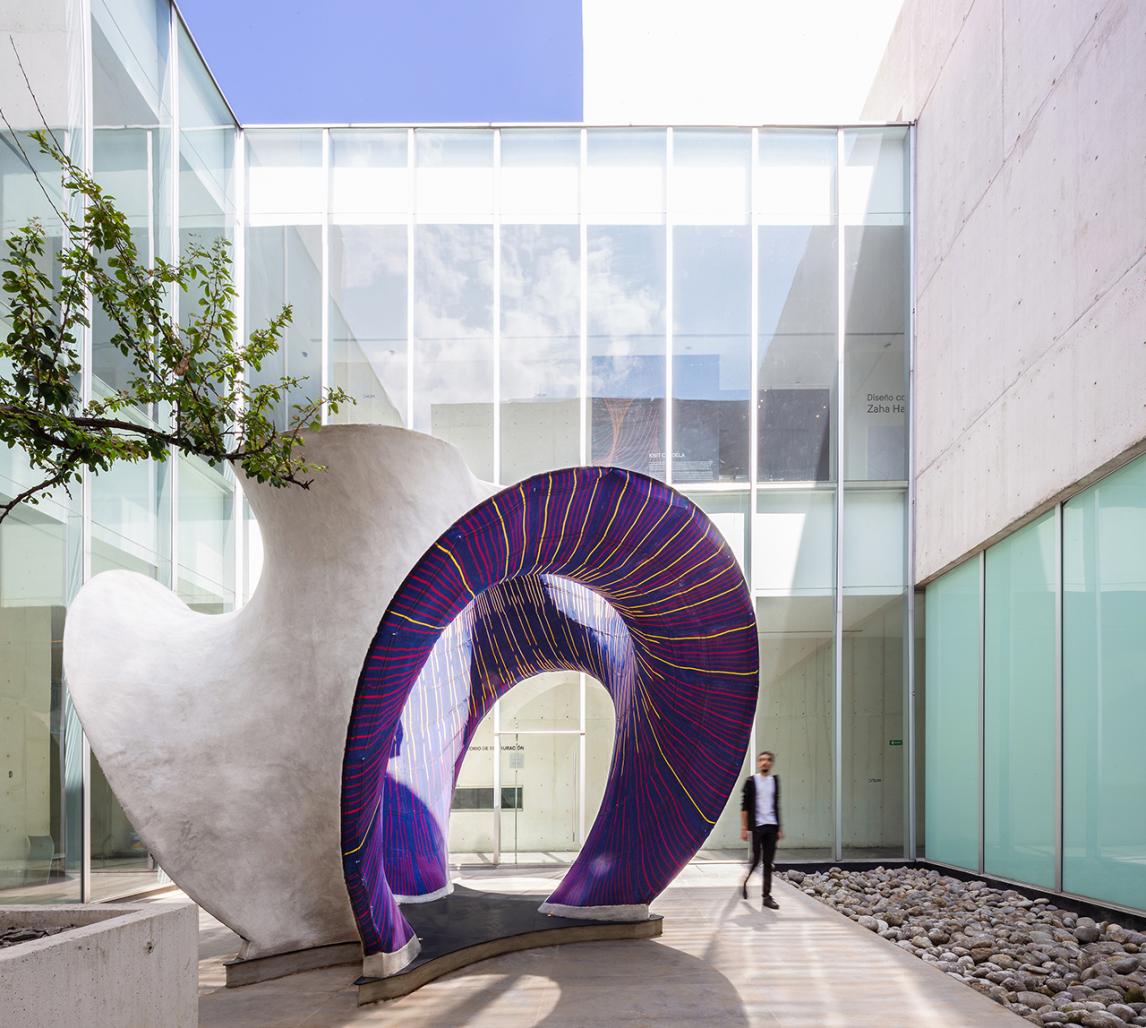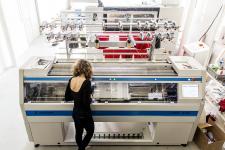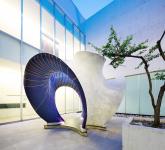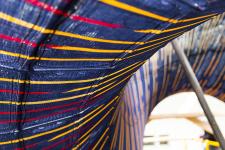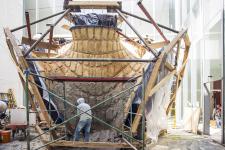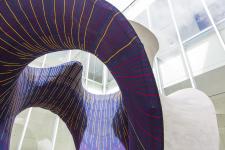Built in the courtyard of Museo Universitario Arte Contemporáneo (MUAC) in Mexico City, KnitCandela is a four-metre tall curved concrete shell, whose formwork is a knitted textile supported by a steel cable net. The prototype marks the first application of this technology on an architectural scale. The shell’s dynamic geometry is inspired by the fluid forms of the traditional and colourful dress of Jalisco, Mexico, while the structure is an homage to, and takes its name from, the famous Spanish-Mexican shell builder Félix Candela (1910 - 1997). It reimagines his spectacular concrete shells through the introduction of novel computational design methods and advanced formwork technology. To enable the reuse of straight formwork elements, Candela used hyperbolic paraboloid surfaces or “hypars”. With the same ambition to reduce construction waste, KnitCandela’s cable-net and knitted formwork system expands the range of anticlastic geometries that can be built efficiently and economically, without the need for complex and wasteful moulds.
Following a computationally generated pattern, an industrial knitting machine produced the shuttering of the formwork for KnitCandela’s shell structure: in 36 hours, the machine knitted a double-layered 3D textile consisting of four long strips. The lower layer forms the visible ceiling – a designed surface with a colourful pattern of stripes. The upper layer contains sleeves for the cables of the formwork system and pockets for simple balloons, which, after the concrete has been applied, become hollow spaces that help save on materials and on weight. Manufacturing a formwork for such a geometrically complex structure using conventional methods would cost substantially more in terms of both time and material.
The knitted fabric strips were brought from Switzerland to Mexico City inside two suitcases - as normal checked baggage. In the museum’s inner courtyard, the knitted formwork was tensioned between a temporary boundary frame and sprayed with a specially formulated cement mixture. This initial layer was just a few millimetres thick, but sufficient to create a rigid mould; once it hardened, conventional fibre-reinforced concrete was applied.
Designed and constructed by multiple teams in Europe and Mexico, KnitCandela was realised in only 3.5 months. This was possible because of a custom-made computational design, engineering, and fabrication pipeline, which allowed for the automatic generation of the sophisticated knit pattern. Also, the ultra-lightweight formwork of KnitCandela was easy to transport; it reduced the need for an additional supporting structure or scaffolding and simplified the logistics on the construction site. Due to the intense time pressure, the external frame was designed and fabricated specifically for this project, but in the future, one can imagine that the edge conditions could be realised with standardised scaffolding components. Furthermore, excluding the falsework frame, the total material cost of the sophisticated formwork was only GBP 1600.
2018
2018
Shell surface area 50 m2 / Covered area: 22 m2
Weight concrete shell vs. formwork: 5 tonnes vs. 55 kg (= 30 kg cable net + 25 kg knit)
Total length yarn: 350 km (= approximately the width of Switzerland)
- Design
Zaha Hadid Architects - ZHCODE: Filippo Nassetti, David Reeves, Marko Margeta, Shajay Bhooshan, Patrik Schumacher
Block Research Group (BRG), ETH Zurich: Mariana Popescu, Matthias Rippmann, Tom Van Mele, Philippe Block
- KnitCrete technology
BRG: Mariana Popescu, Tom Van Mele, Philippe Block
Chair of Physical Chemistry of Building Materials, ETH Zurich: Lex Reiter, Robert Flatt
- Fabrication and construction
BRG: Mariana Popescu, Matthias Rippmann, Alessandro Dell’Endice, Cristian Calvo Barentin, Nora Ravanidou
Architecture Extrapolated (R-Ex): Alicia Nahmad Vazquez, Horacio Bibiano Vargas, Jose Manuel Diaz Sanchez, Asunción Zúñiga, Agustín Lozano Álvarez, Migue Juárez Antonio, Filiberto Juárez Antonio, Daniel Piña, Daniel Celin, Carlos Axel Pérez Cano, José Luis Naranjo Olivares, Everardo Hernández, Ramiro Tena.
- Structural engineering
BRG: Andrew Liew, Tom Van Mele
- Concrete development
Holcim Mexico: Jose Alfredo Rodriguez, Carlos Eduardo Juarez, Delia Peregrina Rizo
- Site construction coordination
R-Ex: Alicia Nahmad Vazquez
